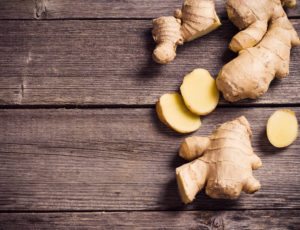By: Mackenzie Elrod
Originating from China and southern Asia, ginger is widely used as a spice in cuisines around the world to add pungent flavors and fragrance to a variety of dishes and beverages. The name ginger comes from the Sanskrit word srngaveram, meaning horn-bodied, referring to the physical characteristics of ginger. While typically thought of as a root, the part of the plant that is consumed is actually a rhizome, an underground stem that grows laterally from the plant’s roots. Throughout the world, ginger is widely hailed as an herbal remedy to treat a range of conditions from the common cold, motion sickness, and nausea, to arthritis, diabetes, and even malaria.
 For many in the United States, your first contact with ginger may have been drinking ginger ale when feeling nauseous or ill as a child. This belief that ginger helps with digestive issues dates back more than 5,000 years to when people in ancient China and India began using it to treat common ailments. Ginger consumption is often recommended to reduce morning sickness during pregnancy as well as other instances of upset stomach. Studies have even demonstrated that ginger powder has powerful anti-inflammatory effects comparable to ibuprofen.
For many in the United States, your first contact with ginger may have been drinking ginger ale when feeling nauseous or ill as a child. This belief that ginger helps with digestive issues dates back more than 5,000 years to when people in ancient China and India began using it to treat common ailments. Ginger consumption is often recommended to reduce morning sickness during pregnancy as well as other instances of upset stomach. Studies have even demonstrated that ginger powder has powerful anti-inflammatory effects comparable to ibuprofen.
In addition to its stomach-soothing properties, ginger is part of a heart-healthy diet and is rich in a number of vitamins and minerals, including potassium, vitamin K, and vitamin C. Potassium helps promote heart health by easing tension in blood vessels, therefore lowering blood pressure, while vitamin K helps the body to process proteins involved in blood clotting and bone metabolism. Vitamin C is a powerful antioxidant that studies have shown may reduce the risk of heart disease.
Pickled ginger is used as a palate cleanser and is typically served with sushi for just this reason. Ginger has a peppery, spicy, and sweet flavor and makes for a powerful addition to many recipes, whether savory or sweet and savory. The distinctive taste of ginger can be enjoyed in many ways.
- Incorporate ginger in a flavorful salad dressing.
- Make a simple homemade tea of fresh sliced ginger, hot water, and honey.
- Use it to provide added zest in a stir fry or curry.
- Incorporate ginger in cookies or other baked goods for a fresh ginger taste.
- Blend it into creamy soups for extra spice and flavor.
- Create homemade ginger ale with grated ginger, lime, honey, and sparkling water
Ginger is easy to add in the mix. Try this great recipe for Pan-Seared Soy-Marinated Pork Tenderloin.


.png?width=1278&name=HHS-company%20logo-final%20(1).png)